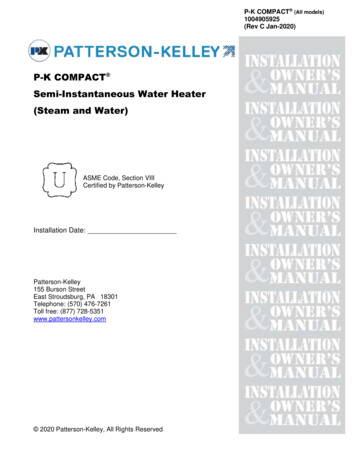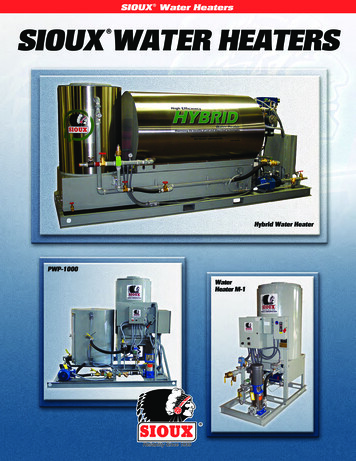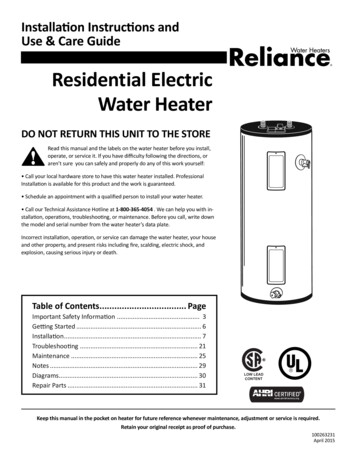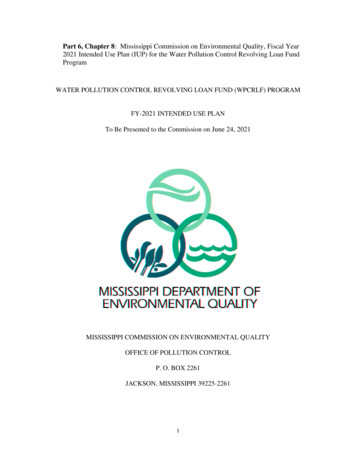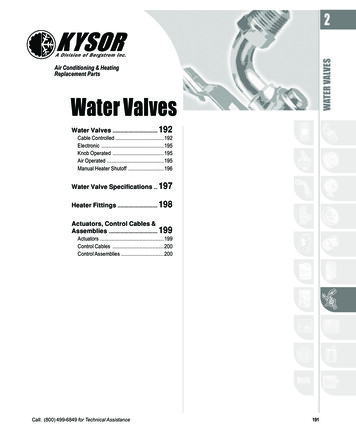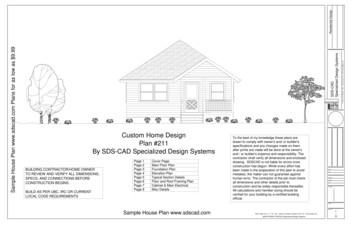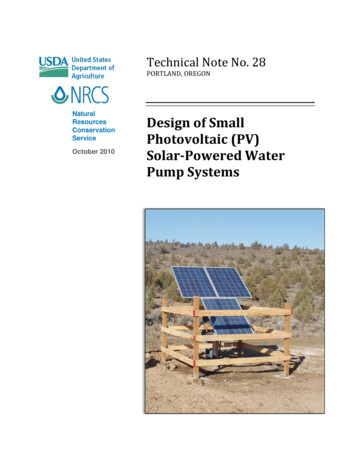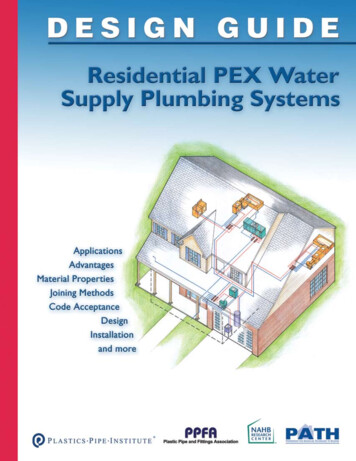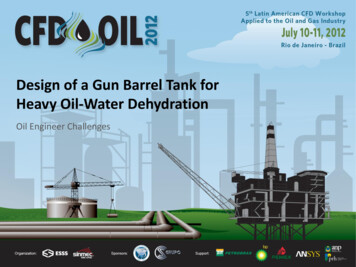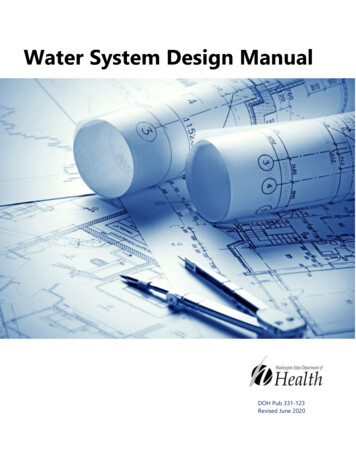
Transcription
Water System Design ManualDOH Pub 331-123Revised June 2020
AcknowledgmentsThis is the fourth edition of the Water System Design Manual. Many Department ofHealth (DOH) employees provided valuable insights and suggestions to this publication.In particular, we are proud to recognize the members of the group at the Office ofDrinking Water who worked over many months to revise this edition of the designmanual: Andy Anderson Jeff Johnson Nancy Feagin Scott Mallery Derek Pell Sam Perry Scott Torpie, Primary Author Linda Waring, Technical EditorWe are especially indebted to the drinking water professionals who contributed theirtime and expertise to reviewing drafts and providing helpful suggestions. We receivedextensive input from the following people: Aziz Alfi (Seattle Public Utilities) Frank Baird (DOH) Stephen Baker (DOH) William Bernier (DOH) David Brown (Washington State Parks) Michele Campbell (RH2 Engineering) Alex Chen (Seattle Public Utilities) Steve Deem (DOH) Terry Englehardt (Hach Company; retired) Melinda Friedman (Confluence Engineering Group LLC) Bill Heubach (Seattle Public Utilities) Sheryl Howe (DOH) Todd Krause (Northwest Water Systems) Doug Lane (City of Bellevue) Jolyn Leslie (DOH) Melanie Mankamyer (Wilson Engineering) Mathew Martinson (Indian Health Service; currently at USEPA Region 10)
Kevin O’Neil (Washington Water Service) Doug Piehl (Northwest Water Systems) Ryan Peterson (RH2 Engineering) John Puccinelli (Washington Water Service) Barney Santiago (RH2 Engineering) Brian Smith (Wilson Engineering) Jeff Sutton (Erlandsen & Associates) Ryan Withers (RH2 Engineering)For more informationOur publications are online at doh.wa.gov/drinkingwater.Contact our nearest regional office from 8 AM to 5 PM, Monday through Friday. If youhave an after-hours emergency, call 877-481-4901.Eastern Region, Spokane Valley 509-329-2100.Northwest Region, Kent 253-395-6750.Southwest Region, Tumwater 360-236-3030.
Table of ContentsChapter 1: Introduction . 11.01.11.21.31.41.51.6Purpose and Scope. 1Safety, Risk, and Reliability . 1Applying the Group A Rule . 2“Must” versus “Should” . 3Engineering Requirements . 4Minimum System Design Requirements . 4Other Referenced Documents and Standards . 4Chapter 2: Project Reports and Construction Documents . 8.22.92.9.12.9.22.102.112.122.132.142.15General Engineering Project Submittal Requirements . 6Project Reports, Construction Documents, and Planning Requirements . 6Submitting Project Reports and Construction Documents . 7Relationship between Project Approval and Operating Permit . 8Project Reports. 8Project Description. 9Planning . 9Analysis of Alternatives . 10Water Quality . 10Engineering Calculations . 11Design Criteria . 11Water Rights and Other Legal Considerations . 11Operations and Maintenance Considerations . 13State Environmental Policy Act Requirements . 13Construction Documents .13Design Drawing Requirements . 14Project Specifications . 15Design Changes after Project Approval . 15Contractor-Supplied Design Components . 16Coordination with Local Approving Authorities .17Design and Review Process .17Submittal Exceptions for Miscellaneous Components and Distribution Mains .17Categorically Exempt . 17Exempt Distribution Main Projects . 18Submittal Exception: Distribution-Related Projects (not Distribution Mains) .18Design and Construction Standards for Reservoirs and Booster Pump Stations . 22Rescinding Submittal Exception Authority . 23Resolving Disputed Department of Health Review Decisions .23Review Fees and Invoice .24Project Approval Letter and Construction Completion .24Construction Completion Report Forms .24Record Drawings .25Safety .25
Chapter 3: Estimating Water Demands . 273.03.13.2Applicability .27Demand versus Consumption .27Consumer Demand .283.2.13.2.23.2.33.2.43.33.4Evaluating Actual Water Demand . 29Full-Time and Part-Time Single-Family Residential Users . 30Analogous Water Systems . 32DOH Default Water Demand Design Criteria (Appendix D) . 33Water System Demand .34Estimating Water System Demands .353.4.13.4.23.5Maximum Day Demand . 35Peak Hourly Demand (PHD) . 36Anticipating Changes in Demand: Systems with Mostly Residential Demand .383.5.13.5.23.6Referencing Data from Prior Years . 38Commercial, Industrial, and Public Facilities . 39Estimating Nonresidential Water System Demand s for Estimating Nonresidential Demands . 41Commercial, Industrial and Public Facility Demand. 43Farming and Crop Irrigation Demand . 44Recreational Development Demand . 45Anticipating Changes in Demand: Systems with Mostly Nonresidential Demand . 47Establishing Needed Fire Flow .48Factoring Distribution System Leakage (DSL) in Design .48Water Resource Issues .50Source Adequacy and Reliability .503.10.13.10.23.10.33.10.43.10.53.113.12Design and Operating Requirements . 50Surface Water Source Reliability . 50Groundwater Source Reliability . 51General Safety Factor and Contingency Planning . 52Summary of Water Supply Reliability Recommendations . 52Factor of Safety .53Example Exercises for Estimating Water System Demand .533.12.13.12.23.12.33.12.43.12.53.12.6New Community Water System . 53Expanding (Existing) Community Water System . 54New Mixed-Use Community Water System . 56Expanding Mixed-Use Community Water System . 57Expanding Noncommunity Water System . 60Assessing Full- and Part-Time Residential Use. 61Chapter 4: Water System Capacity Analysis . 664.04.14.24.2.14.2.24.2.3Introduction.66General Expectations .67ERUs, Connections, and Population .67ERUs . 67Connections Served . 68Population Served . 69
4.34.4Applying the Concept of Equivalent Residential Units in Design .69Determining Water System 14.4.4.24.4.54.4.64.5Methodology to Determine Water System Capacity.844.5.14.5.24.5.2.14.5.2.24.5
6.2.2 Minimum Size. 149 6.2.3 Peak Hourly Demand . 150 6.2.4 Fi re “Suppression” Flow . 150
